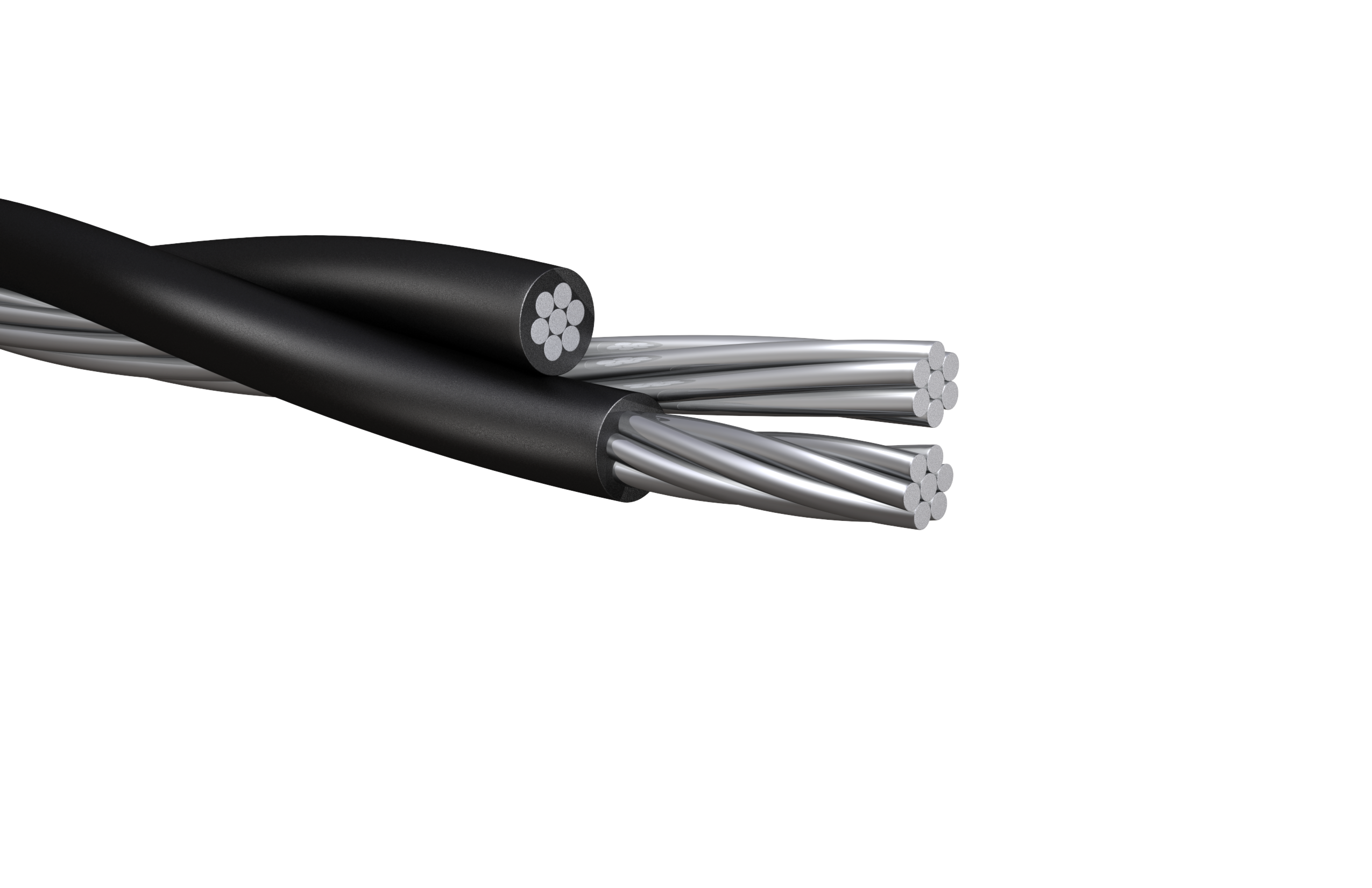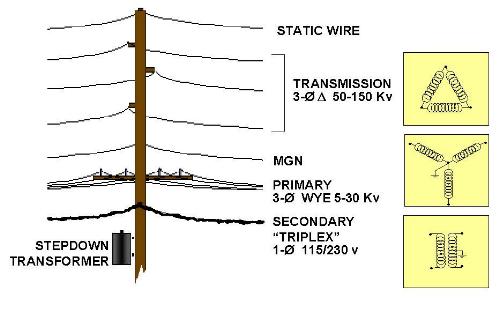Open wire secondary involves bare conductors, while triplex uses insulated wires twisted around a bare neutral. Both systems distribute electricity to homes and businesses.
Open wire secondary systems are traditional and cost-effective but pose safety risks due to exposed wires. Triplex systems offer improved safety and reliability with insulated conductors. Open wire setups are more susceptible to weather-related damage, while triplex systems provide better protection against environmental elements.
Triplex cables also reduce electromagnetic interference, enhancing overall performance. These factors make triplex a preferred choice for modern electrical distribution. Both systems serve their purpose, but triplex stands out for its enhanced safety and efficiency. Understanding their differences helps in making informed decisions for electrical infrastructure.

Credit: www.houwire.com
Introduction To Power Distribution Options
Choosing the right power distribution system is important. It ensures efficient and safe electricity supply. Two common options are Open Wire Secondary and Triplex. Understanding each can help you decide the best for your needs.
Importance Of Choosing The Right System
Choosing the right system affects safety and reliability. A good system reduces power losses. It also minimizes maintenance costs. Incorrect choices can lead to frequent outages. It can also cause safety hazards.
Overview Of Open Wire Secondary And Triplex
Open Wire Secondary uses separate wires for each phase. These wires are mounted on poles. This system is simple and cost-effective. But, it is more exposed to weather and physical damage.
Triplex combines three wires into one bundle. It has a neutral wire and two insulated wires. This design protects the wires better. It also reduces installation time and costs. Triplex is more durable and less prone to faults.
| Feature | Open Wire Secondary | Triplex |
|---|---|---|
| Installation Cost | Low | Moderate |
| Durability | Low | High |
| Weather Resistance | Poor | Good |
| Maintenance | High | Low |
Open Wire Secondary Basics
Open Wire Secondary refers to the power lines delivering electricity. These wires are typically used for residential and small commercial areas. They are essential for distributing electricity from transformers to consumers.
Design And Structure
Open Wire Secondary systems consist of multiple conductors. These conductors are mounted on poles and are not insulated. The wires are usually made of aluminum or copper.
These systems have a simple design. The wires are often spaced apart using insulators. The structure is straightforward, making it cost-effective.
The table below outlines the key elements:
| Component | Description |
|---|---|
| Conductors | Aluminum or Copper |
| Insulators | Spacers for Wires |
| Poles | Support Structure |
Common Applications
Open Wire Secondary systems are often used in residential neighborhoods. These systems are ideal for small commercial areas too. They are also used in rural and suburban settings.
Key applications include:
- Power distribution in residential areas
- Electricity delivery to small businesses
- Rural electrification projects
Open Wire Secondary systems are reliable and cost-effective. They provide a straightforward solution for power distribution.
Triplex Cable Fundamentals
Understanding triplex cables is crucial for efficient electrical distribution. These cables are widely used in various applications due to their unique features and capabilities.
Composition And Features
Triplex cables consist of three conductors. Two conductors are insulated, and one is bare. The insulated conductors are typically made of aluminum. They are covered with a durable cross-linked polyethylene (XLPE) insulation.
| Component | Material | Function |
|---|---|---|
| Insulated Conductors | Aluminum with XLPE | Carry electrical current |
| Bare Conductor | Aluminum | Neutral support |
The insulation provides protection against weather and physical damage. The bare conductor serves as the neutral. It also supports the weight of the cable.
Typical Uses
Triplex cables are commonly used in overhead service applications. They are ideal for delivering power from utility poles to buildings. These cables are suitable for both residential and commercial properties.
Key uses include:
- Overhead service drops
- Street lighting
- Temporary power supplies
These cables are preferred due to their durability and efficiency. They can withstand harsh weather conditions. Their design also makes installation and maintenance easier.
Comparing Durability
In this section, we will compare the durability of Open Wire Secondary and Triplex. Durability is a critical factor for electrical wiring, impacting safety and longevity. Let’s delve into the specifics of how each type holds up under various conditions.
Resistance To Environmental Factors
Open Wire Secondary wiring is more exposed to environmental elements. This exposure can lead to damage from rain, wind, and UV rays. Triplex wiring, on the other hand, has a protective covering. This covering shields it from harsh weather, making it more resilient.
| Type | Environmental Resistance |
|---|---|
| Open Wire Secondary | Low |
| Triplex | High |
Longevity And Maintenance
Open Wire Secondary wiring requires frequent maintenance. This is due to its exposure to the environment. Triplex wiring, with its protective coating, lasts longer. It needs less frequent repairs and maintenance.
- Open Wire Secondary: More frequent maintenance, shorter lifespan.
- Triplex: Less frequent maintenance, longer lifespan.
In the end, Triplex wiring offers better durability. Its resistance to environmental factors and reduced maintenance needs make it a superior choice for long-term use.
Safety Considerations
Understanding the safety considerations between Open Wire Secondary and Triplex is crucial. Both have their own safety benefits and risks. This section will explore important factors to help you make an informed decision.
Risk Of Electrical Hazards
Open Wire Secondary systems are more exposed to the environment. This increases the risk of electrical hazards. Triplex cables, on the other hand, have an insulated design. This reduces the risk of direct contact.
Here is a comparison of the risks:
| Risk Factor | Open Wire Secondary | Triplex |
|---|---|---|
| Exposure to Elements | High | Low |
| Risk of Electrocution | High | Low |
| Maintenance Needs | Frequent | Less Frequent |
Safety Protocols
Both systems require following strict safety protocols. These ensure the safety of workers and the public. Here are some key protocols:
- Use insulated tools.
- Wear personal protective equipment (PPE).
- Follow electrical safety guidelines.
- Conduct regular inspections.
These protocols help minimize risks associated with electrical systems. For Open Wire Secondary, extra caution is needed. This is due to its exposed nature.
Triplex cables offer better safety through insulation. This does not eliminate the need for safety protocols. Regular checks and maintenance are still essential.

Credit: www.annsgarden.com
Cost Analysis
Choosing between Open Wire Secondary and Triplex involves various cost considerations. This section breaks down the costs into initial investment and long-term costs.
Initial Investment
The initial investment for both Open Wire Secondary and Triplex varies. Below is a table that highlights their costs:
| Type | Material Costs | Installation Costs |
|---|---|---|
| Open Wire Secondary | $2,000 | $1,500 |
| Triplex | $1,800 | $1,200 |
Long-term Costs
Long-term costs include maintenance and operational expenses. Open Wire Secondary may incur higher maintenance costs. Triplex tends to be more durable.
- Open Wire Secondary: Higher maintenance costs, frequent checks
- Triplex: Lower maintenance, longer lifespan
Considering these factors, Triplex might offer better long-term savings. It requires less frequent maintenance. Open Wire Secondary needs more checks and repairs.
Installation Process
The installation process for Open Wire Secondary and Triplex varies in complexity and requirements. Understanding these differences can help in choosing the best option for your needs.
Complexity And Time
Installing Open Wire Secondary involves managing multiple conductors. This can be complex and time-consuming. Each conductor must be properly spaced and secured. Installation may take several hours or even days.
For Triplex, the process is more straightforward. The cables are pre-twisted, reducing the complexity. Installation time is often shorter, sometimes just a few hours.
Required Tools And Equipment
Both types require specific tools and equipment. Here’s a comparison:
| Equipment | Open Wire Secondary | Triplex |
|---|---|---|
| Conductor Spacer | Required | Not Required |
| Insulators | Required | Optional |
| Twisting Tool | Not Required | Required |
| Safety Gear | Required | Required |
Installing Open Wire Secondary needs more tools and equipment. This adds to the complexity of the installation process.
On the other hand, Triplex requires fewer tools. This makes the installation process simpler and faster.
Understanding these differences can help you make an informed decision. Whether you opt for Open Wire Secondary or Triplex, knowing the installation process is key to a successful project.
Choosing The Right Option
Choosing between Open Wire Secondary and Triplex depends on your specific needs. Both have unique advantages and limitations. Understanding these will help you make an informed decision.
Project Requirements
Your project requirements play a crucial role in this decision. Consider the following factors:
- Distance: Open Wire Secondary can span longer distances without voltage drop.
- Environment: Triplex is better suited for urban areas with limited space.
- Cost: Open Wire Secondary is generally more cost-effective.
Each project has unique needs. Assess these carefully to choose the right option.
Expert Recommendations
Experts recommend considering the following:
- Safety: Triplex offers better insulation and protection.
- Maintenance: Open Wire Secondary is easier to repair and maintain.
- Installation: Triplex can be easier to install in tight spaces.
Consult with industry professionals. Their insights can help guide your decision.
| Criteria | Open Wire Secondary | Triplex |
|---|---|---|
| Distance | Longer | Shorter |
| Environment | Rural | Urban |
| Cost | Lower | Higher |
| Safety | Moderate | High |
| Maintenance | Easy | Moderate |
| Installation | Moderate | Easy |
Conclusion And Final Thoughts
Choosing between Open Wire Secondary and Triplex can be challenging. Each type has unique advantages and disadvantages. Here, we summarize key points and help you make an informed decision.
Summary Of Key Points
- Open Wire Secondary: Cost-effective, simple installation, but prone to weather damage.
- Triplex: Durable, resistant to weather, but more expensive upfront.
- Safety: Triplex offers better safety with insulated conductors.
- Maintenance: Open Wire Secondary requires frequent checks, Triplex less so.
| Feature | Open Wire Secondary | Triplex |
|---|---|---|
| Cost | Lower | Higher |
| Durability | Less durable | Highly durable |
| Safety | Less safe | More safe |
| Maintenance | High | Low |
Making An Informed Decision
Consider your budget. Open Wire Secondary is cheaper but less safe.
Think about weather conditions. Triplex withstands harsh weather better.
Evaluate safety needs. Triplex is safer with its insulation.
Assess maintenance capabilities. Open Wire requires frequent checks, unlike Triplex.
Use this information to choose the right solution for your needs.
Credit: www.quora.com
Frequently Asked Questions
What Is An Open Wire Secondary?
An open wire secondary is a type of electrical power distribution using bare conductors. It is supported by insulators on poles. This method is common in rural areas.
What Is The Difference Between Triplex And Quadruplex Wire?
Triplex wire has three conductors, while quadruplex wire has four. Triplex is used for single-phase service; quadruplex for three-phase service.
What Is A Triplex Wire?
A triplex wire consists of three conductors twisted together. It’s commonly used for overhead power distribution.
What Is The Difference Between Primary Wire And Secondary Wire?
Primary wire carries electricity from the power source to a transformer. Secondary wire distributes electricity from the transformer to end-users.
Conclusion
Choosing between Open Wire Secondary and Triplex depends on your specific needs and budget. Open Wire Secondary is cost-effective and simpler. Triplex offers better insulation and durability. Assess your requirements carefully before deciding. Both options have their advantages and can serve your electrical needs efficiently.


